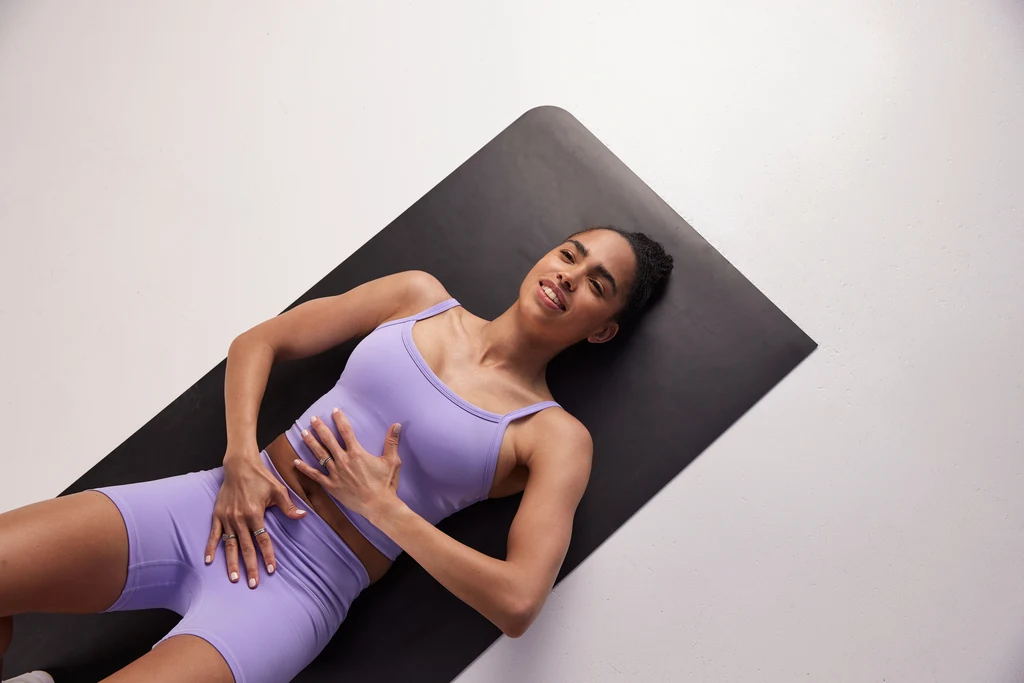When Can You Start Working Out After Giving Birth?
Once you have clearance from your healthcare provider to start exercising, you should take a gradual, progressive approach to rebuild your strength and fitness and ensure you return to exercise safely.

November 22, 2019 - Updated August 21, 2024

Every journey through trying to conceive, pregnancy and giving birth will be different! Not only is every woman different, but no two pregnancies are the same. While regular exercise is an important part of leading a healthy lifestyle and there are several postpartum exercise programs available in the Sweat app, if you're a new mother, you may need to take into account the experience your body has been through during pregnancy and birth as you plan your return to exercise.
Getting started with exercise after giving birth
New mothers can experience a number of challenges that may make it hard to begin exercising again. Whether you struggle to find time to exercise or you don’t know where to start, getting the right guidance and support can help you to rebuild your fitness with confidence.
Work with your healthcare team to determine when to start
When - and how - you can return to exercise depends on a range of factors including whether you had a cesarean birth or vaginal delivery, or any complications that may have arisen during your pregnancy or birth. Your healthcare provider will clear you to return to exercise, but when this happens might differ from woman to woman and it doesn’t mean you go straight back to your usual workout routine either.
The American College of Obstetricians and Gynaecologists says that for women who had a healthy pregnancy and normal vaginal delivery, it's usually safe to begin exercising a few days after you give birth. However, it's important to remember that if your birth wasn't straightforward, it will take your body longer to heal (after all, a caesarean is a major abdominal operation!), so be patient as you wait for your doctor to give you the all-clear. Your pregnancy and birth can both influence when you can start exercising and what exercises you should begin with as you embark on a gradual return to fitness.

Take it slowly
When you first start to exercise post-pregnancy, you may find that your body feels very different than it did before pregnancy. Start with kegel exercises and short walks — even 10 minutes of walking is a great way to start out!
“Slowing down during pregnancy and postpartum has allowed me to learn how to truly listen and appreciate what my body is telling me,” says Britany Williams of her own approach to post-pregnancy workouts after the birth of her daughter, Blake.
Sarah Smith agrees, highlighting how everyone’s journey is truly unique.
“I would just say that all you need to do is nourish your body with food that will fuel your day and recovery,” she says. “Try and move in some way every day, whether that's a stretch, a 10-minute workout or a short stroll to the coffee shop.”
Co-founder and head trainer Kayla Itsines also took things slow after pregnancy, and her first workout after the arrival of Arna only lasted a couple of minutes. From there, she slowly increased her sessions minute by minute, opting for light walking on the treadmill as Arna slept to start.
Listen closely to your body during this postpartum period and only increase the volume and duration as you start to feel physically fitter and stronger.
Follow a progressive program
If you don’t know where to start with rebuilding your fitness after giving birth, try following a program designed with postpartum women in mind. This is the best way to find workouts that will include the right movements for your body and give you the guidance that you need.
There are multiple post-pregnancy programs available in the Sweat app from Kayla Itsines, Kelsey Wells, Britany Williams and Sarah Smith - all of which take a gradual approach to help strengthen your body while focusing on the common concerns women face after pregnancy.

Be kind to yourself
As a new mum, you are going through a lot of change (and can we just say, we think you’re doing a pretty incredible job). During this time, you may feel a range of physical changes and fluctuating emotions, and this is totally normal. Remember that your body has just done a monumental thing! Give yourself time to adjust to the changes you've been through and make time for self-care - this could be a few minutes of stretching or relaxing with a cup of tea!
“Don’t set your expectations too high and focus on making movement accessible,” says Sarah. “Yes, it’s great to have intentions to train when your baby is taking a nap but sometimes we need to focus on self-care and use that time to rest as well.”
Being mindful of your body and energy will help you ease back into fitness at a pace that is best for you at this time.
Short workouts are where it's at
Let’s face it, you’re probably sleep-deprived and struggling to find the time to wash your hair, let alone schedule a workout.
Even if you only have 10 minutes spare to exercise, that’s okay! Just 10 minutes of walking, stretching or strengthening can still make a difference to how you feel. Kayla’s Post-Pregnancy program includes 10-minute postural workouts that focus on common problem areas post-pregnancy, including lower back, hip strength and upper body strength, and Britany’s Post Pregnancy Core & Restore program includes a variety of sessions that range from 10-30 minutes.
“My biggest advice when you return to exercise is to meet your body and your schedule where they are. Short simple sessions are super effective at this stage - you have so much going on, it’s okay to focus on the basics and not worry about the fancy stuff,” says Britany.
Find support
Becoming a mother is a significant change in your life! Many new mothers find that joining a mother’s group with other women who gave birth at a similar time can help provide support and connection to you and your baby.
The Sweat Community is another fantastic place to meet like-minded women who might be juggling exercise with early parenthood. Connect with women around the world on the Sweat Forum or via social media.
Which post-pregnancy program should I do?
There are four post-pregnancy programs to choose from in the Sweat app. Once you’ve been cleared to exercise by your healthcare professional, you can follow the program that best suits your postpartum goals and work out from the comfort of your own home and with minimal equipment.

Post-Pregnancy with Kayla Itsines
Kayla’s Post-Pregnancy Program was designed to help women restart their fitness journey after pregnancy and is suitable for women with Diastasis Recti (abdominal separation). It has 16 weeks of workouts and you can choose to begin with four Foundation Weeks if you’ve had a C-section or other complications during birth.
This flexible program contains short workouts that take 15-25 minutes, and focus on rebuilding foundational core and pelvic strength before progressing to larger, more complex movements.
There are also optional 10-minute postural workouts that you can do when you're short on time. These workouts focus on common problem areas after pregnancy, including your lower back, hip strength and upper body posture. The circuits are lap-based, so you’ll complete each of the exercises in your own time.

PWR Post-Pregnancy with Kelsey Wells
PWR Post-Pregnancy is a program by Kelsey Wells that aims to help women improve their self-confidence and love for their body after pregnancy and birth.
There are 28 weeks of workouts, with the first eight weeks focusing on healing and restoring your body as you rebuild core strength and improve your posture. The focus then shifts to regaining muscle tone and strength. Each session is 28 minutes long, with time-based circuits.
This program is also suitable for women who have experienced diastasis recti.

Post-Pregnancy Core & Restore
Post-Pregnancy Core & Restore with Britany Williams is a gentle and progressive 12-week program that is designed to help improve and minimise common postpartum issues such as diastasis recti, pelvic floor dysfunction, back pain, poor posture and muscle weakness.
This program includes a variety of breathwork and posture exercises and aims to help you rebuild strength after pregnancy through bodyweight training, barre, resistance bands and dumbbells.
You have 3-4 weekly sessions in Post Pregnancy Core & Restore, which will take you 10-30 minutes. Britany encourages you to take this program at your own pace, which is why many of the sessions are optional and differ in focus and difficulty throughout the 12 weeks.
While not strictly a post-pregnancy program, Britany also has her 12-week Core & Restore program - a great option for women who no longer consider themselves postpartum but are still experiencing lingering core or pelvic floor issues and are looking to improve their breathing, core engagement, strength and posture.

Post-Pregnancy with Sarah
Sarah’s 12-week post-pregnancy program will help you ease back into exercise after giving birth, with a focus on strengthening your pelvic floor and core, improving mobility and boosting your overall energy levels and full-body strength.
Each week you have four to five optional workouts that will take 20-30 minutes to complete. These sessions are diastasis-recti friendly and include a variety of low-intensity strength exercises and mobility work, with a new training focus every four weeks to help you gradually progress.
Everybody’s post-pregnancy journey is different
As a new mother, there are many demands on your time so remember to go at your own pace and make modifications where necessary. You've just made the first step in restarting your fitness journey by selecting the right post-pregnancy program for you, so take a moment to congratulate yourself! We recommend you consult your healthcare provider before starting a program or increasing the intensity of your exercise after completing any post-pregnancy program.
Sweat's post-pregnancy programs can provide you with the guidance to gradually rebuild your strength and fitness, and you can connect with other mothers and share tips, advice and motivation within the Sweat Community on our forum and on social media.

A more empowered you starts with Sweat, and our editorial team is here to bring you the latest fitness tips, trainer recommendations, wellbeing news, nutritional advice, nourishing recipes and free workouts.
* Disclaimer: This blog post is not intended to replace the advice of a medical professional. The above information should not be used to diagnose, treat, or prevent any disease or medical condition. Please consult your doctor before making any changes to your diet, sleep methods, daily activity, or fitness routine. Sweat assumes no responsibility for any personal injury or damage sustained by any recommendations, opinions, or advice given in this article.
Disclaimer: Although exercise during and after pregnancy has been associated with multiple health benefits, you should consult with and obtain permission from your physician or other healthcare provider before starting this or any other fitness program to determine if it is right for you, especially while pregnant and in the months following your pregnancy. Not all exercise is suitable for everyone or every pregnancy and exercises, including those contained in this article, may result in injury. Do not start this fitness program if your physician or healthcare provider advises against it. This article is for informational purposes only. Any instruction, information, or guidance contained in this article is not a substitute for medical advice, consultation, and/or medical treatment from your doctor or healthcare provider. Do not delay seeking medical advice, disregard medical advice, or discontinue medical treatment because of any instruction, information or guidance contained in this article. You are responsible for your own safety and are participating in this fitness activity at your own risk. Start slowly and do not exceed the exercise recommended by your physician or health care provider. If you experience faintness, dizziness, pain, discomfort, bleeding, or shortness of breath at any time while exercising, stop immediately and seek medical advice.
Fitness